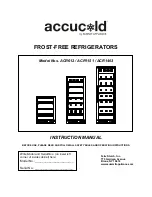
Before use
Operation
Cleaning
When in trouble
25
Troubleshooting
Troubleshooting
Page 6
Page 4
Page 21
Heat discharging
pipe
Condensation
Prevention Pipes
Page 16
Page 16
Page 4
Set to “COLD or COLDER” or
to the setting of your liking.
Is the flow of cold air being blocked?
Are the doors being opened frequently,
or left ajar? Is food blocking them?
Make space between foods and remove any food that
is sticking out of shelves or touching the ceiling of the
drawers. Avoid opening and shutting the door for a while.
Is heat discharging being blocked?
Check if there is no gap around the
refrigerator and the refrigerator is
exposed to direct sunlight.
Is the temperature on the operation
panel set to “COLDER”?
Check that there is enough space around the refrigerator
and that it is properly installed.
Set the temperature to “COLD”. Also, the temperature with
each setting may temporarily decrease.
Food in the refrigerator compartment or vegetable compartment
may freeze. Freezing is less likely when the temperature
settings are set to "LESS COLD".
Has enough time passed after
installation?
It takes 4 to 5 hours for the refrigerator to cool, and may
take 24 hours in summer to fully cool.
Is the temperature setting set to “LESS COLD”?
Place drinks and food containing a lot of water,
such as tofu, vegetables and fruits, at the front of
the shelf or in a door pocket.
Is food with a lot of moisture stored at
the rear of the shelf?
Is the surrounding temperature 5 ™C or
less?
There is a
rattling sound
Are any nearby objects in contact with
the refrigerator?
Leave space around the refrigerator. When objects or walls
are in contact with the refrigerator, sounds may be heard.
Loud noises
Worrisome
noises (Noises
described on the
right are normal)
The noise gets louder suddenly
or the tone changes.
Immediately after beginning use, when the weather is hot,
when the doors are frequently opened and closed, and in
similar situations, the refrigerator switches to high-speed
operation and cools with high power.
A whistling sound is made after closing a door. This is the sound of the cooling fan motor starting.
A whipping or dripping sound is sometimes
heard from inside the refrigerator after
a door is opened.
This is the creaking sound as warm air enters and expands
the plastic.
Sometimes the sound of flowing or boiling
water can be heard.
This is the sound of the refrigerant (gas) flowing.
Sound
Doors do not
close
Doors open
easily
Is a door making contact with food or a
case? Is too much food packed inside?
Store food so that the door does not make contact with the
food when closed. In the refrigerator compartment, store food
on the shelves and in the drawer doors store food so that it
does not make contact with the ceiling when doors are shut
and opened.
Has food fallen behind a case in a drawer
door, or is the power cord or another object
trapped between the refrigerator and
a door?
Remove any objects. Make sure that the door does not trap
objects such as food, power cords or plastic bags.
Is the refrigerator installed stably?
Are the adjustable supports making contact
with the floor?
Lower the adjustable supports to raise the front side slightly
and make the doors easier to close.
The alarm
will sound
Check if the doors are closed.
Refer to “When the door alarm sounds” and “When the
alarm cannot be turned off”.
Page 5
Page 22
Door




































